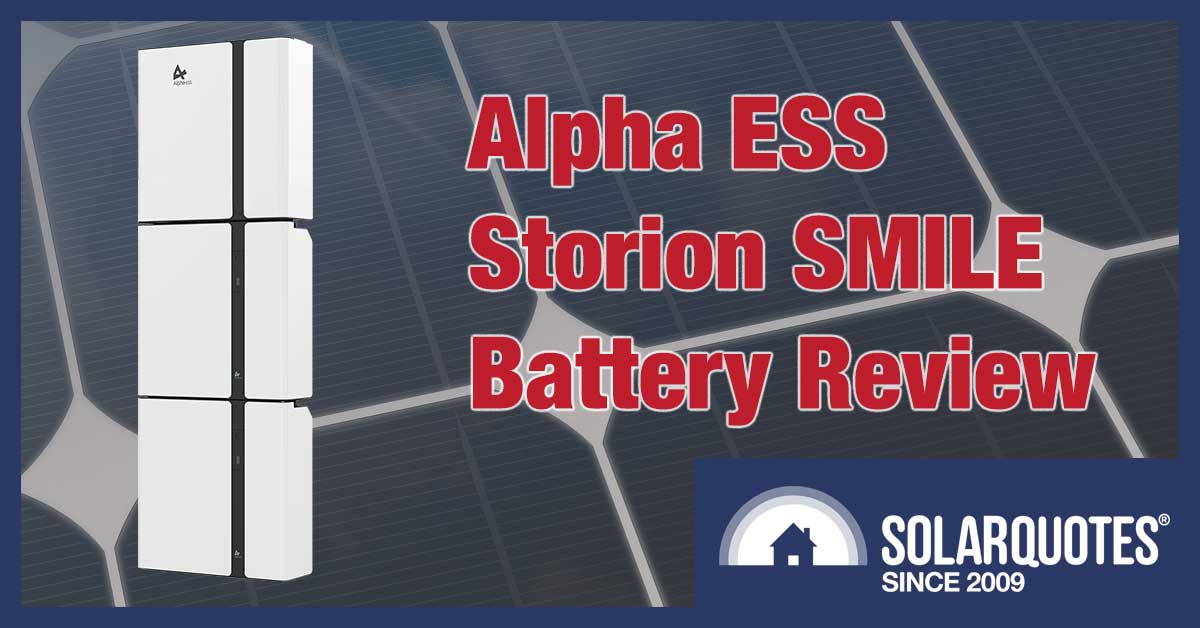
The Alpha ESS Storion SMILE battery is the second battery eligible for the SA Battery ‘rebate’. But is it worth considering?
Update: SQ’s in-house installer, Anthony, has more recently written about the Alpha ESS SMILE5 battery here.
Alpha ESS is a Chinese manufacturer of home battery systems. Because they have promised to do some assembly in Adelaide they are now the second company eligible to receive South Australia’s substantial home battery subsidy, as reported by Michael here. More batteries will become eligible in January.
According to the South Australian Government’s Home Battery Scheme site, there are two models of Alpha ESS battery system eligible at this time — the Storion-SMILE-B5-GW and the Storion-SMILE5. But Alpha ESS has told me these two models are almost identical.1 They have the following features:
- From 5.5 up to 33 kilowatt-hours of usable storage when new. Currently available systems have 5.5, 11, and 16.5 kilowatt-hours of usable storage.
- Power output of 2.8 kilowatts for a system with 5.5 kilowatt-hours of usable storage and 4.6 kilowatts for all larger ones.
- A built in 4.6 kilowatt hybrid inverter. This makes it an all-in-one system and rooftop solar panels can be connected directly to it.
- It can also be AC coupled and operate alongside any existing home solar system and solar inverter.
- When solar panels are directly attached to its hybrid inverter it can charge its batteries with them during a blackout and also function as an Uninterruptible Power Supply (UPS).
- It’s suitable for outdoor or indoor installation.
- The inverter and any components other then the battery modules have a 5 year warranty. The battery modules have a 10 year warranty when used for self consumption.
The number of companies in South Australia that can sell subsided Alpha ESS systems is rapidly increasing. Last week there were two and today there are six. I contacted Suntrix because they were one of the first and they were kind enough to tell me their pre-subsidy and post-subsidy prices for a fully installed Storion-SMILE-B5 GW with the following amounts of usable storage:
- 5.5 kilowatt-hours: $9,042 without subsidy, $6,192 after SA subsidy or $5,622 for concession holders.2
- 11 kilowatt-hours: $13,992 without subsidy, $8,292 after SA subsidy or $7,142 for concession holders.
- 16.5 kilowatt-hours: $17,220 without subsidy, $11,220 after SA subsidy. (No change for concession holders.)
This makes Alpha ESS much cheaper than the alternative eligible systems from Sonnen3, but their warranty is not as good. Note that even with the SA subsidy your home will need a high enough overnight electricity consumption and a large enough solar system for a battery to be cost effective.

Well, what do you know? Alpha ESS has managed to make a battery system smile. (Image: Alpha ESS)
Company Information
Alpha ESS was founded in 2012 and its headquarters are in the Chinese city of Nantong. Currently more than 10,000 of their residential and commercial battery systems have been installed worldwide, with thousands of them in Australia. They have an office in Sydney and presumably will have one in Adelaide any second now.
The battery modules Alpha ESS uses are manufactured by the Chinese company EVE which stands for Energy Very Endure.4 This company was founded in 2001 and is a large manufacturer of batteries for Chinese electric cars and other purposes. Their company song is awesome.
The Battery Module Is On The CEC Approved List
The Clean Energy Council has recently created a list of approved energy storage devices and the battery module Alpha ESS uses in their Storion-SMILE-B5-GW is right at the top! There is only one reason why the CEC gave it the number one position and that is because the list is in alphabetical order.

If you want to see what other systems are on the little list, it can be downloaded from this page. Being on the list does not mean a system will work perfectly without any problems, but it does mean it should meet Australian standards and be safe. By safe, I mean safe in the way I have no problem typing this with my fingers only centimeters away from a potentially explosive lithium laptop battery I also have no fear of putting a phone with a lithium battery into my pants or shoving it against my face.5 But while we usually consider them to be safe, laptop and phone batteries do explode on rare occasions so you can’t be 100% certain your battery system will be safe. But hopefully you will be no more likely to die from a home battery exploding or catching on fire than you are from being killed by a short circuit in your air conditioner or a ceiling fan falling on your head.
There’s not a lot of money to be made in selling battery systems that kill people, but to be on the safe side you should only buy batteries that are on the CEC approved list. If it’s not on the list I wouldn’t touch it with a 10 foot pole. Not unless the pole was well insulated.
Problems With The Alpha ESS Website
Alpha ESS appears quite proud their systems can receive the South Australian Battery subsidy during the exclusive period that lasts until the end of this year…
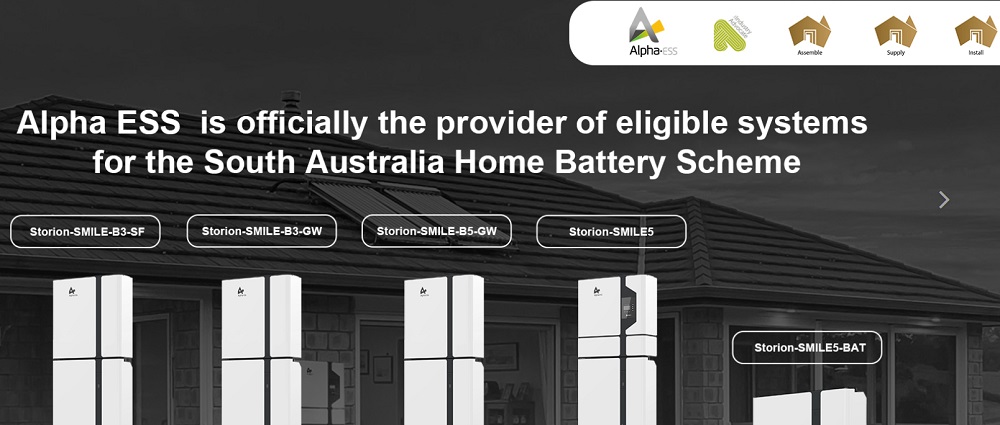
Goddammit Alpha ESS! Despite what the screenshot above from your site says, you are only A provider, not THE provider. Does Sonnen, the German company whose battery systems can also currently receive the subsidy, know you are saying stuff like this? Trust me, you don’t want to go picking fights with Germans. My grandfather lost a fight to some Germans and they took over his entire country.
While only the Storion-SMILE-B5-GW is available at the moment, there are 5 different battery systems in the image above. On the page that is specifically about the SA battery subsidy they show 4 systems. Each has a trio of brown, origami looking Australias above it, which make it look as though they don’t know where Adelaide is. It instead seems to be emphasizing the middle of nowhere. You need to be on the grid to get the subsidy and geographically-speaking, there is only grid in the south-east of the state.
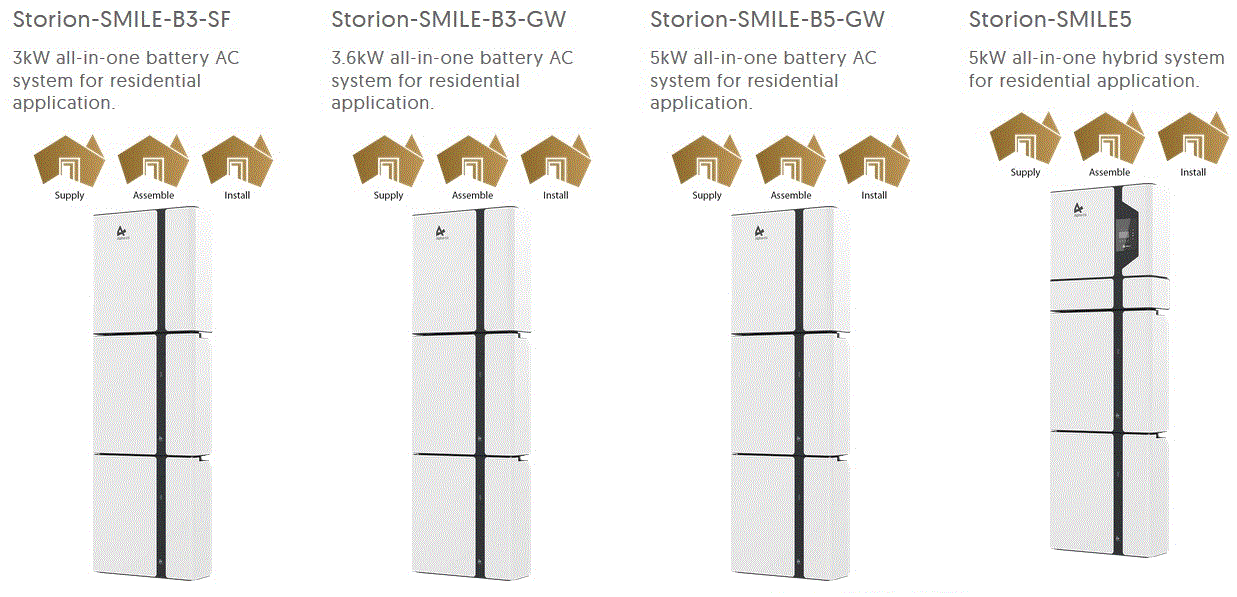
You can see on the image above it says the Storion-SMILE-B5-GW is a 5 kilowatt battery system which most people would reasonably mean it can supply 5 kilowatts of AC power. But according to its inverter technical specifications, its maximum AC output is only 4.6 kilowatts.
Technical Specifications — Battery Module
Here are the technical specifications of the EVE battery module the Storion-SMILE5 systems use:
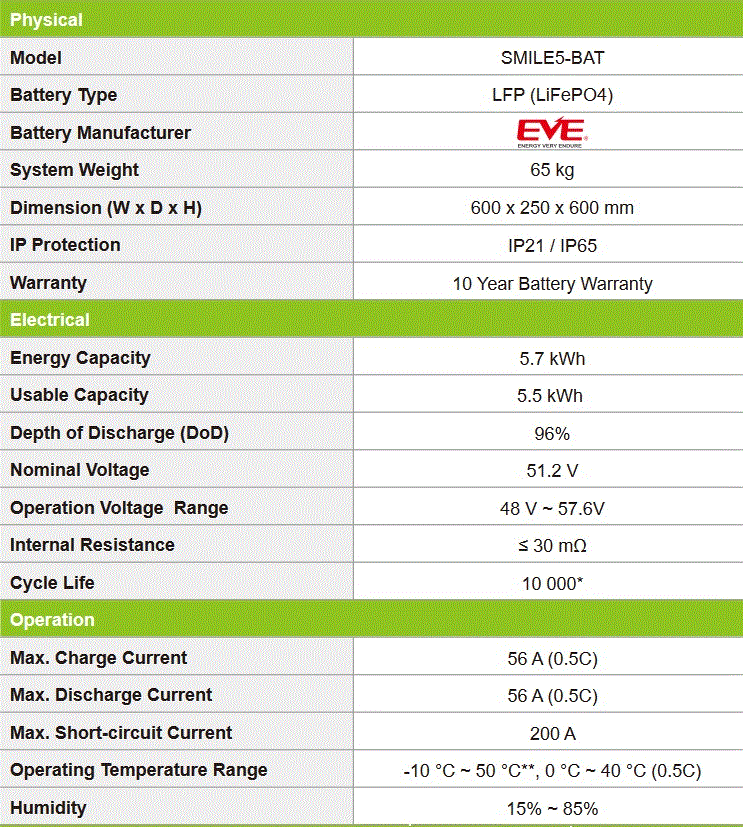
If you look at the weight, you can see at 65 kg the modules are pretty heavy. A system with three of them may weigh even more than I do.
Technical Specifications — Inverter
Here are the technical specifications of the hybrid inverter in the Storion-SMILE-B5-GW.
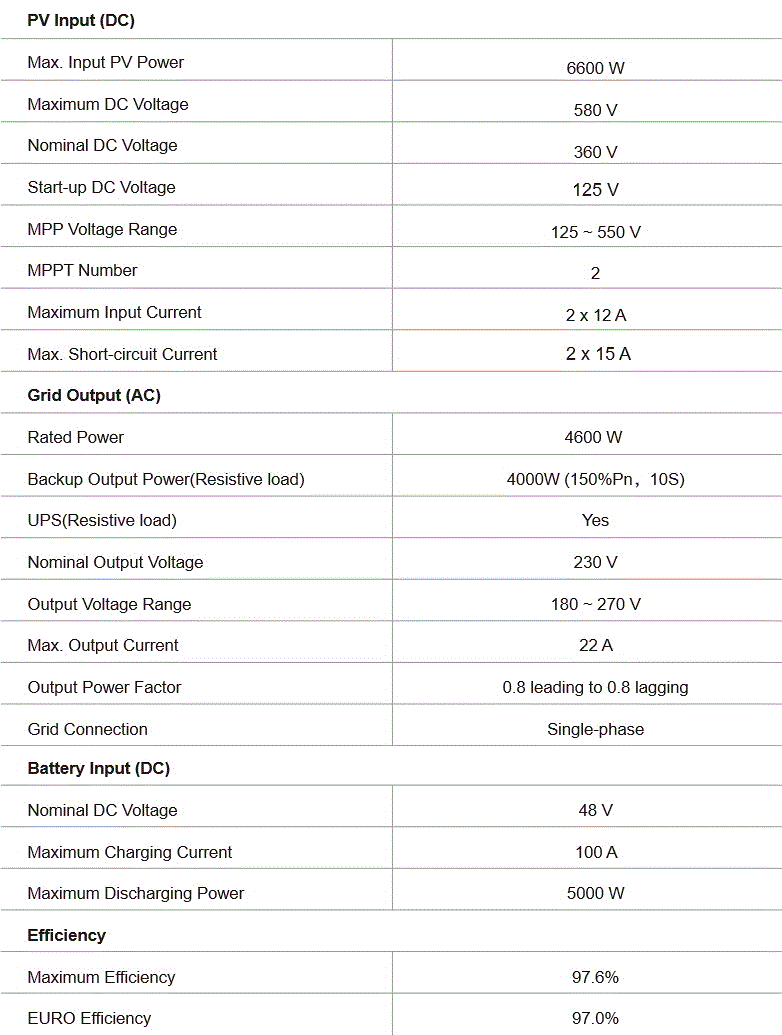
Battery Chemistry
The battery modules are lithium iron phosphate, which is the safest type of lithium battery technology. But just because a battery system uses the least dangerous chemistry doesn’t mean it will be the least dangerous system. It will depend on how well it’s designed and how reliable its components are. It’s like the difference between petrol and diesel cars. Diesel is a safer fuel, but a petrol Volvo is always going to be less dangerous than a diesel trabant.
That said, until we have a better idea of who makes the safest systems, if safety is a major concern you are better off going with the safer chemistry.
Energy Storage Capacity
The EVE battery modules the Storion-SMILE5 uses have a nominal capacity of 5.7 kilowatt hours and can have a depth of discharge of up to 96%. This makes the effective storage capacity of each module 5.5 kilowatt-hours. As a system can have 1 to 6 modules the total usable storage capacity can range from 5.5 to 33 kilowatt-hours. Currently only systems with 1 to 3 modules are on offer in South Australia. These give usable capacities of:
- 1 module = 5.5 kilowatt-hours
- 2 modules = 11 kilowatt-hours
- 3 modules = 16.5 kilowatt-hours
But if you want more than this and don’t mind paying extra for battery modules that won’t be subsidised, you should be able to get extra ones.
Power
Unfortunately, the descriptions given on the Alpha ESS website don’t make it clear to the casual reader how much power the Storion-SMILE-B5-GW can provide. The number “5” figures prominently in its name and their site they straight out say it’s a 5 kilowatt system:
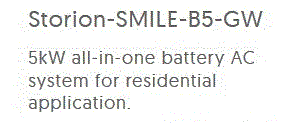
Most people would quite reasonably conclude this refers to the system’s AC power output. But if you look at the battery technical specifications above you can see its maximum charge and discharge rate is give as 56 A or 0.5C:

This mean it can only charge and discharge at a maximum of half the battery’s nominal capacity of 5.7 kilowatt-hours.6 So a system with one battery module will only be able to supply around 2.85 kilowatts of continuous power. But this will be DC power and not the AC power homes use. If the inverter’s average efficiency of 97% applies then 2.85 kilowatts of DC power will be reduced to 2.76 kilowatts of AC power.
A battery system with 2 or more modules will be able to supply more power but it will be limited by the 4.6 kilowatt AC output of its inverter.
DC Coupling
As an all-in-one system the Storion-SMILE-B5-GW can be DC coupled. This involves connecting rooftop solar panels to its built in hybrid inverter as shown in this illustration from the Alpha ESS site:
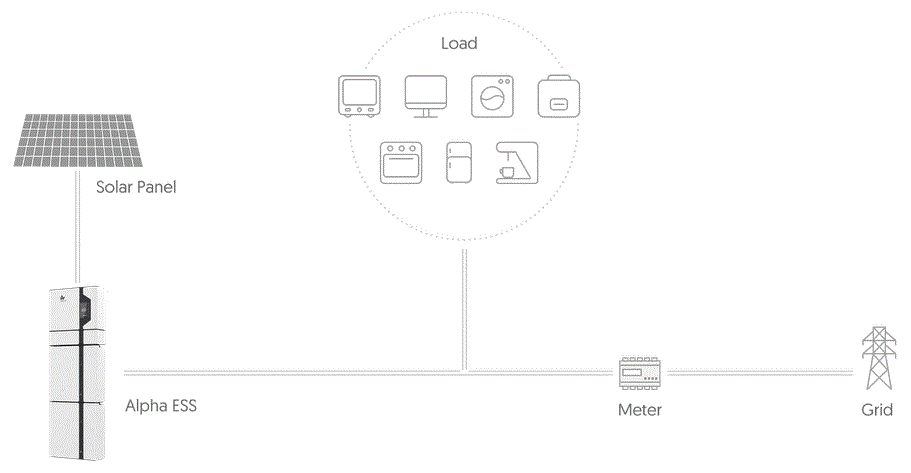
If you are installing a new solar system this can save you the cost of a standard solar inverter and so the system may be better value than it first appears. In this configuration the battery system can provide backup power during a blackout.
AC Coupling
If you already have a solar system installed it may be more convenient to AC couple the Storion-SMILE-B5-GW as shown below.
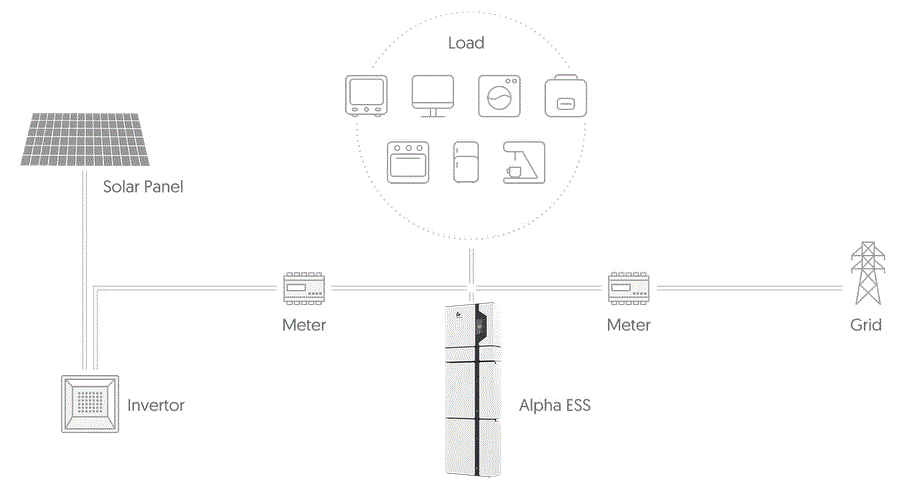
With this arrangement the battery system will be able to function no matter what type of solar inverter is already installed or what the solar panel capacity is. But if the solar capacity isn’t large you may have difficulty charging your battery. Unless there are special circumstances it won’t be able to provide backup power in this configuration.
Hybrid
It is possible, although uncommon, to combine DC coupling and AC coupling:
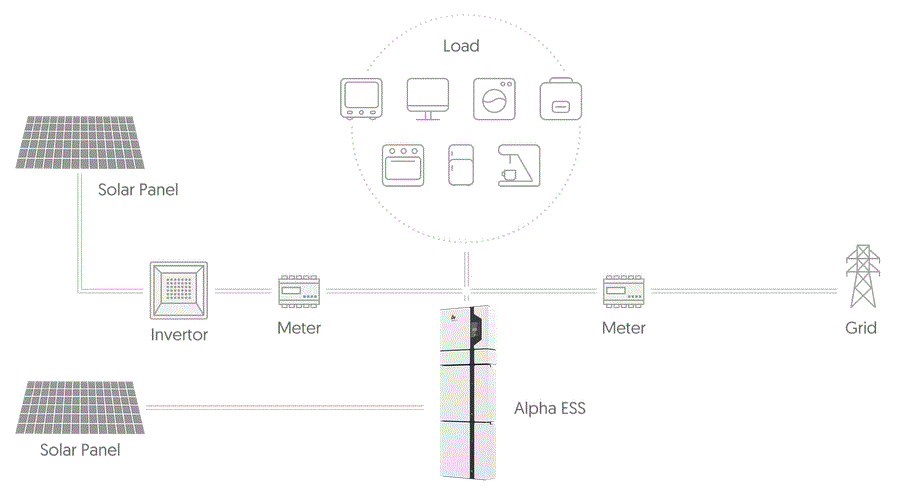
This could potentially be done where there is an existing solar power system you wish to keep but you want additional solar capacity to help charge your batteries.
Backup Power
When solar panels are directly attached to the Storion-SMILE-B5-GW’s hybrid inverter it is able to provide full backup and charge its batteries from the solar panels during the day. It also functions as an Uninterruptible Power Supply, or UPS. This means when a blackout occurs electrical devices that are able to draw on the power supplied by the battery should not have their functioning interrupted.
During a blackout the maximum amount of AC power the inverter can supply is 4 kilowatts.
When AC coupled the Storion-SMILE won’t be able to provide backup power except in the unlikely situation where the existing solar inverter is a hybrid that can allow the home to operate off-grid.
Weight & Dimensions
With 2 battery modules and 11 kilowatt-hours of usable storage the SMILE-B5-GW will be 180cm tall, 25cm deep, and 60cm across. Or at least it is according to one set of figures from the Alpha ESS site. According to another set it’s just a little larger. Each additional battery module will increase its original size by one-third.
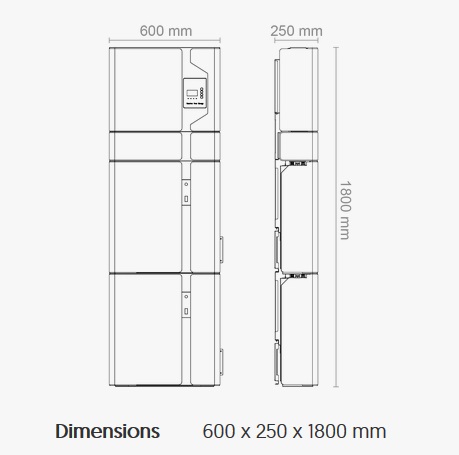
Each battery module weighs 65kg and the inverter is 58kg, so a system with 11 kilowatt-hours of usable storage should weigh 188kg.
Installation Location
The SMILE-B5-GW is able to withstand rain and can be located indoors or outdoors. It is best to keep it out of the sun to prevent it getting too hot to operate.
Operating Temperature
The system is able to operate normally at temperatures from 0 to 40 degrees. From 0 down to -10 degrees and from 40 up to 50 degrees the batteries will still be able to charge and discharge, but at a reduced rate. In most of Australia reduced power output could be an issue during heatwaves. And in some parts of Australia it could be an issue during coldwaves.
The Warranty
The Australian warranty can be downloaded from this page. The warranty for the inverter and everything that isn’t a battery module is 5 years. The warranty for the batteries is better and promises they will retain a minimum of 80% of their original capacity after 10 years, but only if certain conditions are met:
- The system has an internet connection.7
- The batteries are used for “self-consumption” only.
If the system isn’t connected to the internet, then the battery warranty will only be for 3 years and Alpha ESS says if you want to make a claim either you or the installer will have to arrange an inspection of the system at your own cost. But under Australian Consumer Guarantees it is possible to claim for reasonably foreseeable damage and loss and this would include the cost of having a system that fails to operate correctly inspected.
While they don’t give a precise definition of “self-consumption”, presumably this means the battery is only discharged to meet household needs. This strongly suggests the battery cannot be used as part of a Virtual Power Plant and still receive the full 10 year warranty. When I mentioned this to ESS they told me that their battery systems were already being used as part of a Virtual Power Plant in NSW and they would update their warranty. But as it currently stands now, it states that when not used for self-consumption:

This condition means if you don’t use the battery only for “self-consumption” and you cycle it an average of 80% or less of its nominal capacity per day, as many households are likely to do, then the warranty will last the full 10 years. But if you cycle it an average of once per day the warranty will only last for 8 years.
I find it interesting that outside the “self-consumption” condition they will only provide a warranty equal to 2,920 cycles when the battery module’s datasheet states its cycle life is 10,000:

They have an asterisk next to it that says it’s “Under specific test conditions”, but that’s not much of an out. No one buys a home battery system to operate it under specific test conditions. If they were confident their battery system would last close to 10,000 cycles, its warranty would reflect it.
As Alpha ESS has said they will update the warranty, if you get one of their systems, I strongly recommend checking if the warranty will be affected by joining a Virtual Power Plant.
They Should Make The Warranty 10 Years For The Entire System
Hopefully in the near future Alpha ESS will offer a 10 year warranty for the entire system. At the moment the inverter could fail after 7 years and leave the owner to puzzle over if it would be worthwhile to pay to have the inverter replaced for the sake of batteries that will be out of warranty in 3 years time. A full 10 year warranty will avoid these situations and make the decision to invest in a system easier. This should increase sales.
Double Check What You Are Getting
I found the Alpha ESS website difficult to follow and confusing at times. Because it’s not completely clear it’s important to double check with your installer that you are getting exactly what you expect and that it will suit your needs. I expect that as Alpha ESS increases their presence in Australia their communication ability will improve.
Footnotes
- Yesterday I learned Alpha ESS will provide a system that will be called a “Goanna Battery“. I suspect this will be the same or similar to their SMILE systems, but I don’t have any solid information on it yet — only marketing fluff. ↩
- The SA battery subsidy is $500 per kilowatt-hour of total storage capacity up to a maximum subsidy of $6,000. Low income earners such as pensioners and people receiving most Centrelink payments receive a subsidy of $600 per kilowatt-hour of storage up to the $6,000 maximum. ↩
- Eguana Technologyies batteries are also eligible for the SA subsidy before January – but since they have flat out refused to tell us their prices when we asked, they can get stuffed. ↩
- No, this is not a joke. ↩
- But I make a point of NEVER licking any of the pictures of goats in bikinis that somehow keep appearing on it. ↩
- The battery’s nominal voltage is 51.2 volts and when multiplied by the 56 A or amps it gives 2,867 watts. The other figure, 0.5C, means the battery can provide power in kilowatts equal to half its total storage capacity in kilowatt-hours. ↩
- In case you’re not aware the internet is a system for transmitting cat videos and pictures of goats in bikinis. But lately its main use has been to complain about how bad the Fallout 76 computer game is. No one seems to understand why such a lousy game was released, but with my degree in shonkology it seems obvious. A competitor just released a game that cost over $300 million to make. It wasn’t possible to put out a game that could compete with it on quality so they deliberately released a game that was so horrible everyone spent their time complaining about how awful it was instead of talking about how good their competitor’s game was. They ripped off their customers and screwed over the competition at the same time. That’s what computer game companies call win-win. ↩

 RSS - Posts
RSS - Posts



Is there any limitation to these type of Lithium battery’s ability to discharge at peak capacity during cold days or nights, say temperatures at around 10 deg C or below? I live in Canberra and it can get cold on some days.
Hi Sam
Lithium batteries (and some others) definitely can have problems charging and discharging when the temperature is below zero degrees. But this is not likely to be a problem for you. The mean temperature in the coldest month in Canberra is 6 degrees and the battery packs are really heavy at 65kg so if temperatures drop below freezing at night their thermal inertia should mean they’ll stay above freezing. And even if they fall below freezing the record low in Canberra is -10 degrees so they should always be able to provide some power. When the batteries are in use they produce a small amount of waste heat so that will help keep them warm. Basically I don’t think you really have anything to worry about. It is possible cold conditions could reduce their output at times but I don’t think the effect would be very noticeable in Canberra.
I have the alpha ess in Canberra and it works well
Hi Gavan,
I am in ACT, getting an alpha battery installed soon. Wondering how your experience has been so far and any tips to be aware of during and post installation.
Let me know. Thanks.
My experience has been great with no issues.
I got the smile 5 10.3 which is on the smaller size.
But for the money there great. I got mine December kast year just before the big price rise. Mine was 6.6 jingo N type , 10.3 kw battery installed for $8900. Bargin
So based on this:
11 kilowatt-hours: $13,992 without subsidy, $8,292 after SA subsidy or $7,142 for concession holders.
I think I would prefer the battery in Solar Quotes battery comparison table which is the Alpha-ESS ECO S5
Listed at a cost of $12,375 for 14.4kWh (12,96 usable)
I don’t know if the prices quoted in the article include installation – even if they do (which I doubt) then I think the ECO S5 would be a much better deal. It seems Alpha no longer makes the ECO S5 which is a shame because it was much more to SMILE about.
Hey Mondo
I spoke to Alpha ESS today and they say they only have a few ECOs left in stock and will soon be switched over to their new SMILE systems.
I was very excited to read this post today and asked Suntrix to attend and quote on a solution for my house. They said that they required a fully refundable $200 deposit before they would make a booking to attend.
They emailed me a quote which will be confirmed during the inspection BUT the $200 deposit is only refundable in the event that:
1. It is determined during my home visit that a battery is nor suitable: or
2. I am unable to secure the subsidy and additional finance (if required); or
3. Additional costs are identified during the site inspection which result in an increase in the price quoted.
Given that the quote in my opinion is not based on a proper needs assessment I see the $200 being a fee for time to attend and assess. Rather than assume that Suntrix is the only supplier for my needs I will look at alternative suppliers.
Ronald,
Can you comment on whether the Alpha-ESS SMILE5 battery system takes over all monitoring of PV + battery to exclusion of other monitoring services, or whether other monitoring systems can co-exist with the Alpha-ESS battery after battery installation?
For example, my PVs have Enphase microinverters which are monitored by Enphase Enlighten web-based system (using Enphase’s Envoy-S sitting behind my meter box). Would the Enphase system continue operation with addition of an Alpha-ESS battery, or would it be rendered useless (if so, the firmware of my Ephase microinverters could not be upgraded by Enphase).
Hi Doug
If you have microinverters the SMILE5 would need to be AC coupled which means it should operate with whatever you already have installed without problem. I presume that as far as the Envoy is concerned it wouldn’t register the existence of the SMILE5.
Dear Ronald,
This is probably out of place here, but I would like to ask.
In the article on your web page; ‘What brand of batteries should you buy?’, there is some mention of the Ecoult Ultra battery. It is stated that it is geared towards larger systems.
Upon a friend’s recommendation, I’ve bought 4 x 6V Narada (3-GFM-300 RC) lead carbon batteries for my RV under construction. These appear to be similar. I decided on these because of safety. I don’t want the 80k project going up in smoke.
IF this is of interest to you can you let me have your thoughts on these and if they have a place into the future? Do you know anything about their discharge rates?
Thank you
Hi Leon
I’m afraid I don’t know anything about Narada batteries, but if they have a supercapacitor built in then they are like the Ecoult Ultra battery. Lead-acids can withstand a pretty rapid discharge if they are made for it — for example a standard car battery — but generally to get a long life out of a battery it is often best to charge and discharge at under one C. That means don’t draw more kilowatts of power than a battery has kilowatt-hours of storage. Looking up the battery I see it supply up to 1.8 kilowatt-hours of electrical energy, so one C would be when it is providing 1.8 kilowatts of power. The supercapacitor presumably will let it briefly discharge at a greater rate without harm. (Note the 5 year warranty is with 45% depth of discharge so at best it can prove up to 0.81 kilowatt-hours if you want to keep the warranty intact.) But the best thing to do is talk with the person you’re buying it from.
For other applications, the warranty can expire earlier if a total energy of 2.92MWh per kWh
usable capacity has been dispatched from the battery.
Can someone expalin this in layman’s terms
Hi David
The battery warranty is for 10 years or until it has provided 2.92MWh of stored energy for every kilowatt-hour of usable storage it has. Which ever comes first. The 2.92MWh figure is equal to 2,920 kilowatt-hours.
As a typical unit will have 11 kilowatt-hours of usable storage when new its warranty will end when it has provided 32,120 kilowatt-hours of stored energy or 10 years pass. So if the owner used an average of 8.8 kilowatt-hours a day from the battery its warranty would last the full ten years. If their average daily use was more than that the warranty would end before the 10 years is up. For most households the warranty would probably last the full 10 years.
Note this warranty is just for the battery. The inverter part of the system only has a 5 year warranty.
Not in ACT it’s not. Full 10 year warranty here
Hi Gavan
Glad to hear you have a full 10 year warranty on your Alpha ESS and not just the battery. If you happen to know, was that supplied by your installer or by AlphaESS? At the moment the AlphaESS website still says their residential batteries have a 5 year product warranty with a 10 year battery warranty, so I’m curious to know if AlphaESS was happy to warrant it for a full 10 years.
I’m pretty sure it has to be 10 years on the ACT government next gen installation. That’s what my installer said. Pretty sure all installation have to be 10 years to be on the list/program
Thanks for that. I was curious.
Hi,
Could you please elaborate how many appliances I would be able to run on a 5.7KWH Alpha ESS/M48200-P System in layman terms? I live in Brisbane and during summer, the ducted 12.5KWH air-conditioning is mostly on all night.
Hi Paul
A 12.5 kilowatt ducted air conditioner is a big beast. Fortunately, the 12.5 kilowatts refers to its cooling power and not its electricity draw. It may draw 4 kilowatts when cooling but the exact amount will depend on its type. Because it won’t run continuously except in a heatwave it may draw an average of 2 kilowatts or less on a typical summer night. If you only cool one room maybe the average will be less than 1 kilowatt. Let’s say it draws 1 kilowatt on average. Since the 5.7 kilowatt-hour battery only has 5.5 kilowatt-hours of usable storage you can power a 1 kilowatt draw for 5.5 hours when the battery is new. (As the battery gets older its capacity will gradually decline.) But if you were cooling multiple rooms during a heatwave the battery might only be able to power the air conditioner for one hour and 20 minutes.
In practice the battery can only provide 2.85 kilowatts of power which means in a blackout it wouldn’t even be able to run your air conditioner. In addition your air conditioner would be 3 phase while the battery is single phase so even if you got a larger battery it still wouldn’t be able to run the air conditioner.
My parents who are in Queensland but don’t have an air conditioner use around 5 kilowatt-hours or less overnight. This is TV, computer, 2 fridges and a freezer, lights, and occasional use of other appliances. So with care and without heating or cooling, the battery could get a home through the night.
Unfortunately it won’t be able to pay for itself in Brisbane and even in South Australia where electricity prices are higher and there is a large battery subsidy conditions would have to be right for it to pay for itself.
The footnotes were very informative, thank you.
I feel that battery storage is still too expensive to be considered an economically strategic decision in the long run.
Hi,
I note your first footnote re: Goanna, I have received from SSG a cold letter to participate in a “Closed Group Testing” of Goanna 3Kw / 5.8Kwh at a price of 5,980. This was revealed to me as the ‘wholesale’ price. After looking through this and other sites I have come to the belief that I was quoted the retail price and that this closed group testing is a ‘sales’ push by SSG. And yes the Goanna is an Alpha ESS smile-B3-SF
Hi Ronald,
as an Electricity Account holder in NSW I received an invitation for a Closed Testing Phase with Alpha ESS in bold print. That lead me to your web site.
I’ve got a solar system with 22 Panels at 330W each (LG).
I would be very interested in complementing this system with a battery (about 10kWh), but according to my research, the only battery type I would contemplate is a vanadium redox battery with none of all those stupid limitations in lifetime, depth of discharge and cycles etc. etc. etc.
Unfortunately I could not find any on the internet suitable for household purposes. What I found is way too big for me.
Would you have any information if, and where I could find what I need?
Would the WA subsidy apply for NSW?
Thanks
Gerhard
Hi Gerhard
If the Alpha ESS was offered at a low enough price it might be worthwhile and pay for itself within its warranty period. But it would have to be a good price. Unfortunately, I know of no vanadium redox battery small enough for household use. Because of their size and low power output compared to energy storage, I doubt one will be developed for home use.
I’m not sure what you mean by the WA subsidy. If you mean the SA battery subsidy that is only for batteries installed in South Australia.
So glad I looked at your page! I to rec a letter from a company, when I rang to discuss they were very rude, even told me I needed to make a decision there and then and put up a deposit. I said I wanted to discuss with my husband and would call them back, they weren’t happy with that at all. I found them very pushy. I can’t wait for their phone call tomorrow, I’m going to let them know I’ve been in touch with you Ronald ? I also read the report done by choice on the Alpha ESS, it didn’t pass their tests!
Hi Ronald I have received a letter for a testing phase too and was offered one of their batteries at a reduced priced. All up it was about $6,500. Should I wait as I can’t find alot of info on these goanna batteries, let alone the company. It seems all abit pushy pushy to get you to sign into the contract but don’t want to miss out if it is such a good deal, as they tell me. So desperately need some advice please.
Hi Helen
There is a good chance that $6,500 is only for a small system with 5.5 kilowatt-hours of usable storage. That is not worth it as it won’t pay for itself. Even if it was for a larger system with 11 kilowatt-hours of usable storage it’s still not likely to save a normal family money. If you are tempted to get it let me know its size and your household electricity consumption first and I’ll let you know its chances of paying for itself.
Thanks so much for your reply Ronald. The battery they have offered at a special reduced price was a Goanna 2.9k Wh battery K29 (Storian-Smile-B3),
1 Alpha ESS B3 BOS, 1 Alpha Internal switchboard.
My daily usage is 17.49kWh at an average cost of $6.23 a day. I get a 12c for my feed in tariff, which I used to get 62 c back when it was first installed quite a few yeArs ago and it’s slowly dwindled down to 12c (was 9c but just had the increase to 12c as from July 2019)
There just seemed a lot of extra smaller charges along the way until the unit is installed and of course it has to be paid within installation date between 2-6 weeks. Is that abit pushy or normal?
Just don’t want to buy a battery that is not even going to meet our needs, let alone help us save money long term. Your help is so much appreciated!!
I’m glad you checked with me too Helen, because that’s a terrible deal. If you are paying 36 cents for grid electricity and getting a 12 cent feed-in tariff and you use the full 2.9 kilowatt-hour capacity of the battery every day then after 10 years it will have only reduced your electricity bills by around $2,500. And you can’t expect it to last too much longer than 10 years so you would never get your money back. And that’s under perfect conditions. In real life it would actually be much worse than that. If you can tell me the name of the company I’ll know to keep an eye out for them in the future.
The latest offer from the same group (now trading as Sunbank Solar Batteries rather than Solar SG Pty Ltd) is offering 40c-70c feed-in tariff once they have established the VPP from people taking up their offer – estimated to be April 2020. They want to run a 5-yr trial and collect your usage data through that period.
I’m trying to understand the payback potential; in the worst-case scenario, the $7,040 cost for the 2.9kW battery (Storion-SMILE-B3 (HIVE)) could be paid off effectively as long as you’re feeding-in an average of 10kWh per day for the 5 year trial?
I would be very cautious. Is that a feed-in tariff only for what the battery feeds into the grid? If that is the case, then they are only likely to feed power from the battery into the grid when the wholesale price of electricity is high, so it’s likely to come to far less than the 2.8 kilowatt-hours of usable energy the battery can store when new.
The name of the company is “Solar Service Group, Solar Battery Experts” located in Box Hill Victoria. Their introduction letter they send out to ‘The Homeowner’ with your address talks about a closed group – testing phase and goes on to tell you that you have been selected to participate in their Initial Testing Phase.
It all sounds good and it doesn’t state that you have to pay upfront for the system but that you will be offered it at a discounted rate for being apart of their testing phase/closed group.
I will add that while talking to a gentleman this afternoon from this company, at no time whatsoever did he mention how much I would save on my bills or how long would it take to make my money back on the system. Lots of fancy talk about how fortunate I was to be selected and approved for this closed group but no information on how much I can save or the exact outlay in total of the system, apart from the $6,578.50 initial outlay, not including unexpected costs (if my fuse box is not compatible, solar panels, wiring, ect)
I’m all up for Solar Battery system, I just think companies need to be so much more honest on what they are selling to a customer, especially us new to all this!!
Thanks for that. I’m no lawyer but their behaviour certainly seems in breech of Australian Consumer Law to me.
Solar Service Group are now pushing the same “deal” in Geelong, as Helen Mace mentions. Thanks for posting Helen and your reply Ronald. It saved me a heap of time trying to research what was on offer. I have just consigned their “offer” letter to the W.P.B.
Th origami looking Australia is in fact a tourist symbol of the state of SA. Check out southaustralia.com.
Yes, I’ve had that pointed out to me. That at least explains why it’s so bad. It must have been designed out of state as it draws the eye to where there is, like, two people. Now I’m not saying those two people aren’t worthy of attention, but there ain’t much tourism going on in that place.
I have a 10KwH Alpha ESS Smile5 with a 6.6 KW set of panels facing east and west. On good days (like today) we generate about 36 KwH, put 24 into the grid (at a measly 8 cents) and house load is around 12. ACT electricity is pretty cheap at 18cents a KwH with a discount, so payback is quite long and marginally economic. But there are other factors such as environmental impact and the sheer satisfaction of taking less than half a KwH from the grid – often nothing. It would be great if the two suppliers in ACT – ACTEWAGL and Origin gave a decent feed-in tariff. However we expect supply charges to increase so that will make the deal a bit better.
I paid $5k for the solar and $9k for the battery.
The system has worked flawlessly but early days still (6 months)
I really appreciate your work, Ronald.
Glad to hear it’s working for you, Bill.
Hi Bill,
Hope you are doing well.
How has your experience been so far with the ESS ? I am in ACT as-well and am looking at getting a battery along with the panels. Looking at the Alpha ESS 10.1.
Wondering if you have any thoughts and comments.
Thanks.
Hi there, yes everything is going fine with our system. We organised the battery through Evergen which has been a good relationship. They can also install Tesla, by that system us bigger and more expensive. We have not had any problems. At moment there is. VPP so we get a $10 a month payment plus $ when they draw on the battery. Not huge but handy.
They don’t do solar installations.
If you like I could send you some data indicating energy use over last couple of years.
Hi Bill,
Thanks for your comment.
It will be great to get some data to look at. I am deciding if a 5.1 or 10kw battery would be suitable. Tesla batteries are too expensive and I quality difference may not be that huge. But happy to take suggestions on that.
Thanks and enjoy the weekend !
I can’t comment on Alpha v Tesla, but just my experience with Alpha. I will put together the data which is pulled from the Evergen portal. This is verified by data from Origen Energy and is pretty close. Do you have an email I can send directly to?
I would recommend the 10kWh battery as long as you have enough generation to charge it. My 6.6kw system is about right.
For who wants to know: I am completely Off-Grid
I use an Alpha ESS Smile5 LifePO4 48V 5.7 KW for over 2 years,
it is a very reliable battery, about every year it maks a self adjusting I think, it takes a few days of strange charging patterns and then is is OK again.
I dislike only one thing, I cannot get any means of communicating with the battery, there is a connection but no one will or can tell me the protocol to communicate (I hope for Visual Basic) – Alpha ESS talks even less than the battery, no response what so ever. Also via de seller, totally no response.
I hope the response is better if I have a guaranty problem.
An other small thing: After I bought the battery and connected this on a (not Alpha ESS supported) inverter, MPPSolar 5Kw, They tell me that the maximum charge is 45 amp, so not the advertised 56 Amp, that is not fine.
The MPPSolar inverter/charger/MPPT is working fine with the battery
Good to hear Hans!! Glad that you are happy with the battery.
I have also been looking at any safety issues with these batteries. Have looked at reviews if you want to install a battery go for Tesla rest have some or the other issues.
It will be good to know thoughts on the issue.
Thanks !
Several contributors have mentioned the offer of participation in a ‘Initial testing Phase’ for a business called Solar Service Group. I’m in Tasmania and received a similar letter.
I’m always suspicious of such ‘cold call deals’ and thanks to the information given on your website by others I will not waste my time making any inquiries to these people. What brought me to the website was the review of the Alpha ESS battery system. Full marks to the detailed and clearly expressed information on your site. It’s a great help when deciding what to do to extend my current PV system (10 x 3.3 Kw Sunpower panels and a Fronius inverter) and whether to also go for battery storage as well.
Another member of the public with a solar system who is glad he receives emails from Solar Quotes. I have also received a letter from Solar Service Group. A great big thank you to Finn and Co especially Ronald Brakels for providing the info that I needed. I too will put the letter in the WPB and again THANK YOU.
Hi Ronald, what do you think of the ShineHub deal offering 10kwh Alpha ESS as part of their VPP for $3k?
I haven’t had a look at the small print on that, so I definitely recommend checking it for problems. I’d also suggesting checking if there are any other VPP trials available and if so, seeing how they stack up in comparison. Apart from that I’m afraid I can’t really say anything.
Ronald is correct. It is marginal on recovery cost, esp since electricity costs have come down. My Origen costs are .19 from grid and feed in just 7 cents. But basically my electricity is free from Oct to March and there is the, you know, warm inner glow of being environmentally friendly. Saving abt $1200 a year and system cost $9,000
We are in a VPP trial that pays $10 a month and $1 per kWh discharged- not a huge income but a bit of cream.
Will be handy when I get an EV.
Hi Ronald I have the same question regarding the 10.3 kw battery being promoted by SHINE HUB for $3,000 plus $500 travel to country on their VPP price sounds good has any one reading this had it installed .
The info says it’s good for 8,000 cycles the idear of being able to capture some of the power I currently can’t use and sell it to the grid using the smart battery at peak all the time having a battery system to supply power in a blackout.
Do you know where I can look to get an idear what you are likely to get selling back to the grid in peak times
I have a 10 kw solar system and a 8.2 kw fronius that is limited to 5 kw per hour which means there are lots of days between 10 and 4 that I cannot Axcess the remaining 3 kw available
regards randy b
Hi Randy
Note the Alpha ESS warranty won’t cover 8,000 cycles or the 10,000 they have also claimed it can do. What they’ll actually cover is a lot less.
I can’t say how good or how bad the Shine Hub offer is as I don’t have enough information on it. But if you have the Shinehub agreement and can send me a copy, I can have a look at it and give my thought on it in an article.
Awesome article mate.
Here’s a question for you.
I’ve got an existing 3 phase Fronius SYMO 15
Shine hub have 20kWh storage available for just under $6500 installed.
AC coupled and and extra $500 to have backup on one phase.
I’ve asked them about configuration 8 and 10 ( article “don’t add battery to a 3 phase home till you’ve read this by Finn)
Configure 8 uses an existing 3 phase inverter and a 3 phase charger/inverter
Configure 10 uses 3x single phase inverters, 1 per phase
Configure 10 would give me 30Kwh storage roughly and be more expensive but I could offset the cost a bit by selling the Fronius SYMO 15.
The question I have for you is:
Can the Aloha batteries operate in config 8 or 10?
Getting an answer of Shinhub is proving difficult.
Thanks for an informative (and funny) article. At the moment batteries are very expensive, but prices will come down. But even if they were reasonably priced, would they be a game-changer or just a nice-to-have? Off-grid, or even covering a sustained power-outage, seems to be beyond their capacity (literally), and peak load can be managed using a home energy management system. So where’s their edge?
Energex are running a home energy management pilot in my suburb, and one of the options is for the ESS 10Kwh battery with 5Kw of solar panels. I already have a 3kw system, so could I have this installed in hybrid mode where the new panels are directly connected and the existing ones via AC from the existing inverter?
I’ve been quoted just over $12k for the system which comes with additional energy management services as part of the pilot. Outside of winter I’m already exporting more electricity back to the grid than I’m consuming, so I suspect I could pretty much cover all my current use, but I suspect the payback on just getting additional panels would be better.
I’ve had the Shinehub 10.3Kwh system installed, and running for about 5 days now.
It’s winter, and it’s been cloudy, my 6Kw of panels have only managed to fill it once so far, and being winter my power use at dinner time is pretty brutal on the battery as the solar has gone to bed by then.
Today, my solar made 16Kwh. 10 of that went into the battery, and the house ate the rest. It’s midnight and I’m still running on green power.
But what I’ve learned so far is that living with a battery is not shutting yourself off from the grid, since the grid and battery are both connected to the house at the same time. When I turn big loads on, the battery supplies up to 5Kw and the rest comes from the grid. During the day, the house uses some solar power and the rest goes into the battery. I’ve learned my house uses more power (in winter) when the sun isn’t shining – dinner, entertaining, heating and breakfast. TVs and computers. Lighting etc.
But I’ve also realised none of this matters. Every Kw my battery absorbs costs me my feed in tariff (18c), but when I use it, it saves me paying 38c (usage tariff). So every Kwh saves me 20c.
So assuming I fill and empty the battery each day (probably reaslistic) I save 20c x 10 KWh x 31 days = $61 per month. I pay $29 per month to buy the battery, including 10 years servicing (whatever that is). So forget payback periods, this is $30 per month saving from day 1, or $360 per year. And at year 10, the system is paid off with no more than half of its predicted cycles used.
Will it run a big aircon unit? Probably not, single handed. But it will take a big dent out of the cost of running it.
I’m also part of a VPP, which may or may not make this a better deal, time will tell. And I’ve yet to test the blackout protection. Hope I don’t need it, but its nice to know its there.
Well that’s my experience so far.
Hi anthony, we are thinking of taking of the Shinehub battery, Just wondering how much you paid or how much anyone else had paid? been quoted $7800 in nsw for the 10.3kw alpha ess battery
There wasn’t an up-front payment for the system. It is simply $39 per month for 10 years. That includes installation, system cost and a 10 year maintenance contract.
So I guess the cost was 39*12*19=$4680 spread over 10 years including maintenance.
Guys, You need to clarify re the Alpha ESS systems available in Australia.
As per the spec sheet here – there are 3 models available in the Alpha Estore range
https://s3-ap-southeast-2.amazonaws.com/solarbrain/uploads/attachment/file/399/6650369a0da5828cbdd8cf8be5bec25d.pdf
The one that seems to be readily available in Australia is the unit with the EM Series goodwe inverter – so max output of 2.5kw – the unit you want is the one with ES series inverter
Confusingly Alpha also have the Smile5 system – data sheet here
https://s3-ap-southeast-2.amazonaws.com/solarbrain/uploads/attachment/file/858/027ed44abf8d6b4b4e3c1913056fe768.pdf
This unit uses an unnamed Chinese knock off inverter that Alpha will not release any specs for – nor provide information about management capabilities other than through the Web interface.
The Smile system seems to be the unit they prefer to push in Australia.
Dear Ronald,
seems to me you ere the expert
So I have a question.
For two years I have an Alpha ESS SMILE5 LivePo4 5.7 KWh, 48v battery, 118Ah
I also have a 5Kw MPPSolar solar/inverter/charger
I run completely off grid in sunny Portugal and have a generator to support me in rainy days
My bulk settings are 56v and my float is 54.4 v – (Alpha ESS wont give me any info sinds i use no inverter from them, so I found these settings on the internet) – I use a Victron SmartBMV battery meter
I charge with max 40amps
Suddently, with no obvious reason, my battery stops charging at about 80%
(Last year it did the same but at 95%, it went OK after some time and some playing with the parameters)
But now I just do not understand.
The battery goes to about 83% and slows down with charging between 79% and 82%, all 5 leds on the battery are on (so >95%) if I reset my victron meter to 100%, than after the night it tells me 20%, According to victron, I used about 100ah, but again it stops at about 80% charge.
Any suggestions to solve this or what it is?
I wish I could help you, Hans, but I’m afraid I have no idea. It may have suffered a fault and is protecting itself as a result. Fortunately, it would still be in warranty and so I’d suggest contacting your installer. (Hope you have good consumer protection over there.)
Hi Ron, I am looking at the SMILE5 10.1WH system with 6.6kW of PV Panels. Before I commit, I would like to check if additional 10.1 kWH battery modules can be purchased and DIY installed in the future or if these need to be professionally installed.
I am also planning to include 3-4 1.5 ton split unit air conds (800W electrical power with 6.8A max on startup) on the backup circuit. I am confident the SMILE5-INV inverter can handle the load, but I also note that the inverter has a AUX contact output that can be activated based on State of Charge or Time of Use. Are you familiar with this as i have not been able to find ut a lot about this.
Ideally, I would like the air-conds powered up if grid power was avaliable or if we have grid outage, the air conds are only powered on the backup circuit if SOC is > say 40%.
I would expect a SMILE 10.1 kWh battery system to be able to handle the start up of an 800 watt air conditioner without problem. However, I am not familiar with current details of the SMILE and it would be something you’d have to check with your installer. If it’s being used off-grid you may have to be careful with how much power is being drawn at the time the air-con is turned on to prevent the inrush tripping the system.
I’m afraid any battery expansion would have to be professionally installed.
I cant seem to find any info with regards the Alpha ESs Storion Smile T10 battery system and monitoring via internet – the data sheets are non-specific. Can they be monitored by WiFi access only or do they require hardwiring via ethernet (may be problematic in large homes where modem is on other side of home). I can’t get much joy out of the solar companies.
Hi Richard,
I’m presently reading through this blog so am unaware if anyone has already answered your question on type of internet access for monitoring.
My AlphaESS Smile B3 Plus 5kWh system (in use for 2 months) can be monitored from my smart-phone, or (usual) the 11.6″ Android Tablet that sits, in front of my place setting, on the dinning room table. The sole annoyance is that monitoring app display is Portrait display only, while my android tablet sits in Landscape mode.
So the ‘net connection to this tablet is household WiFi. (I have two WiFi “hotspots” – the modem in my computer room, and the TP-Link powerline network powerpoint module behind the TV (tv visible from dinning table).
During Spring the sunny day charge cycle shows that my 6kW of panels can charge the battery from low of 14.8% to 100% by 10.00AM EST.
During initial use in August / September, that sunny day full capacity was usually by 11.00AM.
Presently battery usage shuts off (at 14.8%) near to 7.00 – 7.30PM EST
I can’t seem to find any info with regard the Storion Smite T10 and monitoring via internet. Must it be hardwired via ethernet or is wifi only suitable. I can’t find anything on their data sheets specifically other than “internet access”. This could be problematic in large homes where modem is in a server cabinet on the other side of the house.
Mine is wifi only.
Mine has a bug which no one wants to fix that if the wifi connection drops, the inverter will not attempt to reconnect until you press the wifi reset button on the front. All data whilst disconnected is lost, and you can’t participate in a VPP event.
Thanks. Thats a real disappointment. My modem automatically kicks over to 4G if there is any drop in NBN. Won’t help if there is a power failure. Are you happy with the system and VPP ? Would be interested to know. I have to make a decision to go with this system by end of close today.
Well it isn’t really the nbn connection, it’s the wifi. If the modem reboots, that drops the wifi, which permanantly kills the inverters connection until it is reset. Recently it has been doing it on a daily basis, but hasn’t for the last week.
I’ve been told there is no connection for ethernet on this inverter, but maybe you could insist on that option when it is installed.
It’s not a show stopper, just annoying. Meter readings show I’m now into slightly negative bills and I get a warm feeling in the evening knowing the whole house is powered from the battery.
Ours is hardwired to Ethernet. The Evergen app gives reasonable data, but is excellent via the web portal. I am participating in VPP and battery has participated in VPP a couple of tones per month (since November.)
Very happy with operation so far.
Hi I am from Adelaide
I bought new I 10kw Solar system and I am thinking of buying battery as well, is it worth it?
Feed in 8.5cents / usage charge 0.34 cents
daily average 10 Kwh
$3980 for 2.9 kw battery Hive or $6261 for 5.04 kw battery Alpha
Will I pay off my battery?
Hi Gerhan
At the moment my general recommendation is not to try it if your motive is to save money. If everything goes well AND you join a good VPP that pays well it might be able to pay itself off, but it’s a real risk. Battery prices aren’t going to come down in the short term because of supply shortages but I’m confident they will eventually come down, so you may want to wait. (Of course, subsidies will also decline so if you wait, be prepared to wait a while.)
Of course, if you place a high value on silent backup power or just like the idea of having a battery you can get one for that reason. If you do decide to get a battery, I recommend getting one you feel confident is reliable and from a manufacturer that’s not likely to disappear from Australia.